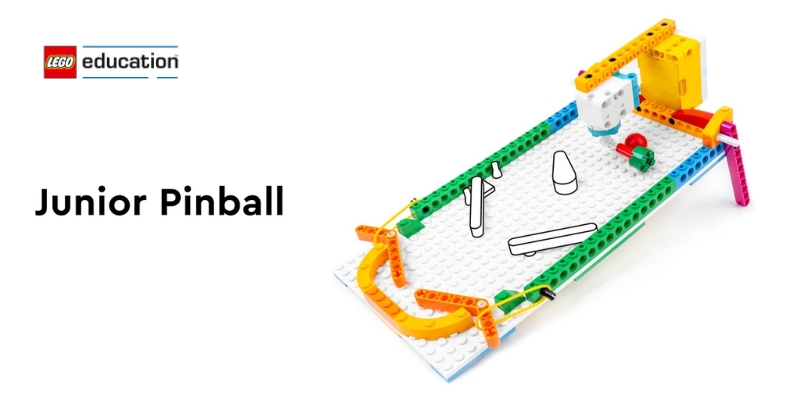
Understanding Energy Transfer with LEGO® Education SPIKE™ Essential
If you’ve ever played pinball, you know it’s a thrilling game in which a small ball bounces around unexpectedly, hitting bumpers and obstacles as it rushes toward points. But have you ever wondered why that ball bounces? It’s all about energy – more particularly, how energy changes and moves in a game like pinball.
In today’s session, we’ll look at the game of junior pinball using the LEGO® Education SPIKE™ Essential set, where we’ll learn about energy conversions and how to create the most unexpected pinball game possible!
Step 1: Energy Conversion – What’s It All About?
Everything around us has energy. You might know about kinetic energy (the energy of motion) and potential energy (stored energy that has the potential to move). When you pull back the plunger in a pinball machine, you’re storing energy (potential energy). As you release the gear of the pinball machine, that energy turns into kinetic energy, making the ball fly around the board. The ball then hits bumpers, obstacles, and other elements, which cause the ball’s energy to change and transfer. So, the challenge here is to figure out how to make this energy transfer more unpredictable. Can you make the ball behave in exciting and unexpected ways? That’s where things get fun!
Energy Transformation and Dynamics in Pinball Play
- Releasing the Ball: When you release the plunger, the stored potential energy transforms into kinetic energy, propelling the ball across the playfield.
- Hitting Bumpers & Obstacles: When the ball strikes bumpers or ramps, its kinetic energy is transferred, changing its speed or direction, resulting in unpredictable movements.
- Flippers and Energy Control: When you click the buttons, the machine turns electrical energy into mechanical energy, which moves the flippers, pushing the ball and returning kinetic energy to it.
- Energy Dissipation: As the ball slows down, it loses some of its energy as heat and sound, particularly when it hits bumpers.
Step 2: The Junior Pinball Challenge – Let’s Build!
Our student’s mission is to create a junior pinball game that’s unpredictable using the LEGO® Education SPIKE™ Essential set. But how? By adjusting the energy flow, adding obstacles, and designing a way for the ball to bounce randomly!
Use the LEGO® Education SPIKE™ App to guide you through the process.
- Build and Test: Your first task is to program the game to start. How can you make the ball go where you want it to? What kind of energy transfer happens when it launches?
- Make It Unpredictable: Next, you’ll tweak your program to add some chaos. Add obstacles that change the ball’s direction and energy, making it harder to predict where it will go. You could add a flipper, bumper, or even an obstacle that sends the ball off in random directions. The key is to create surprise!
- Upgrade the Game: Want to make it even more challenging? Add more obstacles and fine-tune the energy transfer.
Step 3: Testing and Tweaking – What Works and What Doesn’t?
Once you’ve built and tested your game, it’s time to reflect. After each test, ask yourself:
- How did the obstacles affect the ball’s energy? Did it go where you expected it to go?
- Did your changes make the game even more challenging?
- What kind of obstacles worked best for changing the ball’s direction? How could you make the obstacles even more exciting?
Remember, pinball is all about surprise and speed. If you’re able to make your game more unpredictable, you’re doing it right! Get your hands on the LEGO® Education SPIKE™ Essential set, which is widely available in schools across Dubai and the Middle East.
Step 4: Reflect and Share – Let’s Talk About It
When everyone’s completed their challenges, gather together to reflect on the design. Share your experiences and ideas with the group. Did you use energy in a way that made the game exciting? What worked, and what could be improved?
Step 5: Wrapping Up – How You Can Level Up
Now, let’s talk about some ways you can level it up!
- Add more motors and sensors to control the speed of the ball. Can you make the ball go faster or slower depending on where it lands?
- Use new coding blocks to get the ball to behave even more unpredictably. How can you control the ball’s path in different ways?
- Refine the obstacles by trying to design new types of obstacles that could change the ball’s path or even stop it in its tracks.
This lesson is all about energy – how it’s converted, transferred, and changed to make something exciting happen, like a pinball game. You learned how to use coding and building skills to make a game that’s unpredictable, just like the real pinball machines.









Recent Comments